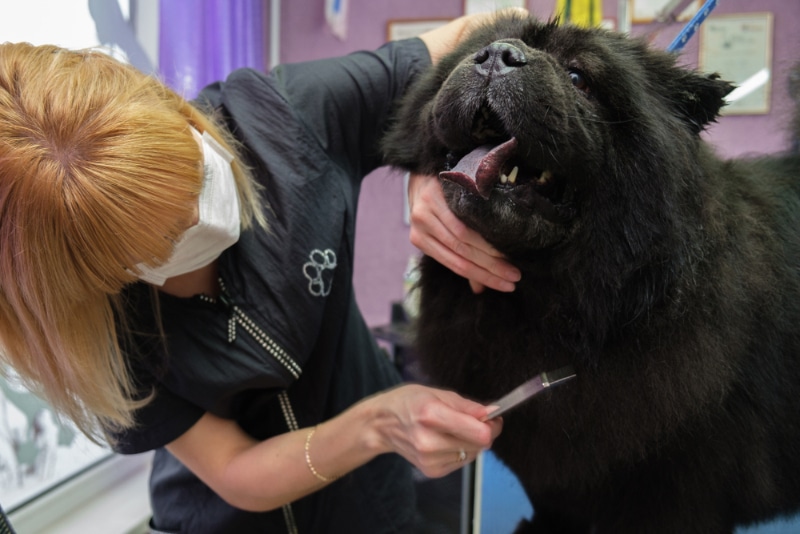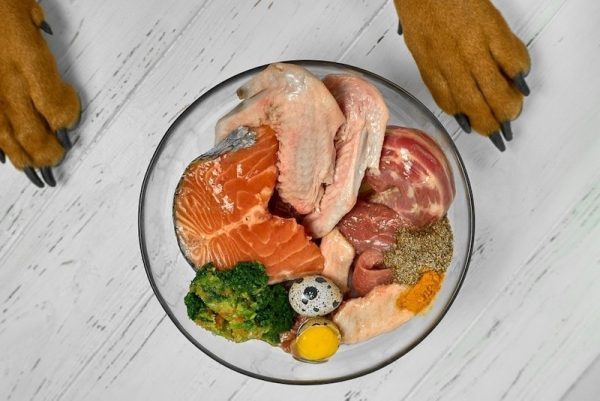In this article
View 8 More +When you see a Chow Chow, you know immediately what you’re looking at! Their fluffy coat and famous blue-black tongue are their most distinctive features. This ancient dog from China is unique in appearance and temperament. If you would like to learn more about this fascinating pup and whether they’d make a good fit with your family, keep reading!
Breed Overview
Height:
17–20 inches
Weight:
45–70 pounds
Lifespan:
8–12 years
Colors:
Cream, red, cinnamon, black, blue
Suitable for:
Experienced families with older children or singles
Temperament:
Reserved, dignified, loyal, adaptable, smart, independent
Chow Chows are among the most ancient breeds. Most experts believe they go as far back as 206 B.C. to China’s Han Dynasty, but it’s thought that they go back even further. They might also be the ancestors of Spitz breeds like the Pomeranian and Samoyed.
They were used primarily for guarding and hunting but also as companions to nobles. They received top recognition from Queen Victoria in the late 1800s, and she fell in love with them and added one to her entourage of dogs. Chows are medium-sized dogs with thick, double-coated fur. They can be black, blue, red, cinnamon, or cream, but they are most commonly red.
Chow Chow Characteristics

Chow Chow Puppies

Chow Chow puppies are readily available through breeders, which shouldn’t make finding one near your location too difficult. Be sure to only deal with ethical breeders and ask them as many questions as you deem necessary. If you don’t do the research and select a cheaper puppy, especially if you don’t interview the breeder, you might end up participating in a puppy mill operation.
Another avenue is adopting a rescued Chow Chow puppy or adult. However, while Chows are well-known, they aren’t common, so it might be a while before one shows up at a rescue organization or animal shelter.

Temperament & Intelligence of the Chow Chow

Chow Chows are, for the most part, dignified and reserved dogs. They are intelligent but quite wary of people they don’t know, and they can be territorial and protective of their families. Since they are so independent, they can appear somewhat aloof but are intensely loyal to their loved ones. Chows can make excellent watchdogs or guard dogs.
Are These Dogs Good for Families? 👪
Chows can make good family pets but do best with older children. They aren’t that playful but, instead, are calm and quiet, and they tend to devote themselves to just one person in the family. Chows won’t put up with much roughhousing and will stay well away from any chaos in the household. However, with the right socialization and training, they can get along with every member of the family.
Teaching your children how to care for the family dog will give them a sense of responsibility, which can help them learn how to treat a dog respectfully.
Does This Breed Get Along With Other Pets?
Since Chows are reserved and independent, they don’t necessarily get along well with other pets. But if they are raised alongside other animals, Chows will tolerate them. Your Chow should be the opposite sex of any other dogs already in the home because they are more likely to have conflicts with dogs of the same sex.
Chows might also treat smaller pets like cats as prey because they have strong hunting instincts. That is why being introduced to these animals as a puppy is practically the only way to have a multi-pet home with a Chow Chow.

Things to Know When Owning a Chow Chow
Food & Diet Requirements 🦴
Your Chow will need high-quality dog food to support their current age, activity level, and weight. If you’re unsure how much to feed your dog, follow the guidelines on your dog’s food bag and speak to your vet. Go easy on the treats, and don’t overfeed your dog. Chows aren’t tremendously active, and their dense coats can hide that they have started to put on too much weight.
Beyond food, your Chow Chow should have constant access to fresh water.

Exercise 🐕
Chows only need moderate exercise, so you’re looking at a couple of 30-minute walks daily. During the hot summer months, you should aim to walk your Chow in the early morning or the evening. Remember that Chows cannot accompany you on vigorous activities like running or biking.
Training 🎾
Training is essential for all dogs, but even more so for the Chow Chow. Their intelligence and independence can make training more of a challenge—and they can be quite stubborn! Plenty of positive reinforcement, patience, and repetition are the only ways to go with the Chow. They need an experienced, firm owner who knows how to handle a strong and independent dog.
In the end, with the proper training and socialization, you’ll have an obedient and well-behaved Chow.
Grooming ✂️
Chows can be rough or smooth coated, but all Chow Chows have double coats that need brushing at least two to three times a week. That said, the rough-coated Chows will likely need daily brushing. However, regardless of coat type, Chows need to be brushed every day during the fall and spring shedding seasons. The most recommended grooming tool is a good slicker brush, followed by a metal Greyhound comb.
You don’t need to bathe your Chow often, as they are naturally clean dogs and don’t have a noticeable doggy odor. Some Chow owners only wash their pups two to four times a year. However, this depends on whether your Chow gets dirty or smelly often. When you bathe them, only use a good dog shampoo, but don’t bathe them too often (like every week) since it will dry out their skin.
Chows should have their teeth brushed daily, have their nails trimmed every 3 to 4 weeks, and have their ears cleaned every 1 to 2 weeks.

Health and Conditions 🏥
Chow Chows are prone to several inherited health conditions, which you should familiarize yourself with in order to recognize the signs.
- Entropion
- Food allergies
- Cataracts
- Hip dysplasia
- Elbow dysplasia
- Brachycephalic airway syndrome
- Gastric dilatation-volvulus
Male vs. Female
Male Chow Chows are heavier and stockier than females, so they should be noticeably larger if you see them standing side by side. Regarding the spay and neuter surgeries, spaying a female Chow is an expensive procedure that will take longer to recover than neutering a male. However, it helps reduce aggressive behavior in males and wandering and vocalizing behavior in females.
If you’re wondering about temperament differences, it’s thought that female dogs tend to be easier to train, but they are not quite as affectionate as male dogs. Some say male dogs are more excitable, take longer to mature, and are more loving.
Each dog is unique and will have their own unique temperament regardless of their sex.

3 Little-Known Facts About the Chow Chow
1. The Chow Chow Was Named by the English in the 18th century
The British gave Chows their name because, back in the 18th century, most items from places like China were called chow chow, which was sort of like saying “knickknacks.” This included clothing, furniture, and, eventually, the dog.
2. Chow Chows Don’t Like Getting Wet
The history of the Chow does not mention them working near water. Those enormously dense, fluffy coats do not do well in water and will weigh them down. Chows typically avoid it.
3. Chow Chows Have a Unique Walk
Chows have straight-back legs that don’t bend quite the same as those of other breeds. So, when you take into account their fluffiness and those stiff legs, you have a dog that thinks that they are a ballerina!


Conclusion
While Chow Chows tend to be relatively aloof and dignified and not always that demonstrative, you’ll likely cross paths with one who is the opposite. However, they need an experienced owner who is willing to put in the time and patience required for training. The Chow Chow is a unique breed that will make an excellent companion for the right owner.
Featured Image Credit: Roman Zaiets, Shutterstock


















